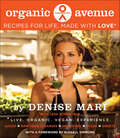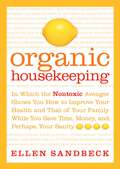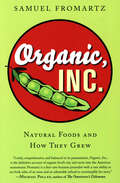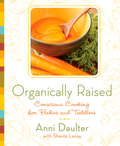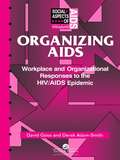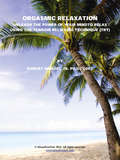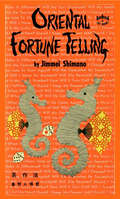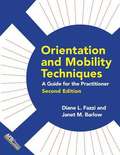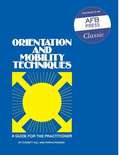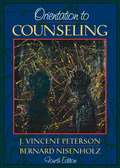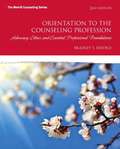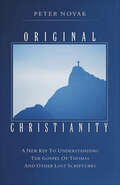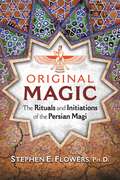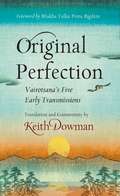- Table View
- List View
Organic Avenue: Recipes for Life, Made with LOVE*
by Denise Mari Leda ScheintaubReplicate the go-to cleanse for Hollywood A-listers at home with this beautifully designed, lavishly illustrated, and inspiring lifestyle book by Denise Mari, founder of Organic Avenue, the hugely popular juice cleansing and raw vegan lifestyle company.Denise Mari, founder of Organic Avenue, went from peddling her fresh juices from a backpack in the Lower East Side of New York to opening a booming business and brand. Her delicious, sustainable, and compassionate food has become a favorite of stars like Gwyneth Paltrow, Jennifer Aniston, and Meg Ryan. Now, through this stunning book, her fabulous juice cleanse programs and nutritious, mouthwatering food will be available to readers who care about being healthy inside and out. Enjoy the juices, elixirs, soups, smoothies, salads, entrees, snacks, and desserts—all using pure, nutrient-rich, organic, and raw ingredients—that have transformed Organic Avenue into one of today's hottest brands.But Organic Avenue isn't just about eating. It's about living. Mari tells the moving story behind her brand's healthy philosophy and shares its ideals—sustainability, compassion, dedication to uncompromising quality, and holistic living—offering suggestions everyone can use to detoxify their bodies and transform their lifestyles to become happier, healthier, thinner and more energized, focused, balanced, and inspired.Illustrated with dozens of gorgeous, full-color photos and beautifully crafted Organic Avenue includes adaptable cleanse programs for bright eyes and glowing skin, weight loss, improved stamina, positive thinking, inner calmness, and mental clarity. Feel good and live well with DIY access to Organic Avenue's never-before-published recipes and philosophy for living.
Organic Body Care Recipes: 175 Homeade Herbal Formulas for Glowing Skin & a Vibrant Self
by Stephanie L. TourlesDiscover the joys of all-natural body care. Stephanie Tourles shows you how to use fruit, flowers, herbs, and minerals to craft healthy products that promote radiant skin, strong nails, shiny hair, and an elevated mood. Pamper yourself from head to toe with products like Strawberry Cleanser, Pineapple Sunflower Scrub, and Almond Rose Body Lotion. Gentle on your skin and free of harsh chemicals found in commercial products, you’ll want to indulge yourself over and over with these luxuriously aromatic bath blends, face masks, and body scrubs.
Organic Housekeeping: In Which the Non-Toxic Avenger Shows You How to Improve Your Health and That of Your Family, While You Save Time, Money, and, Perhaps, Your Sanity
by Ellen SandbeckLonging for a kinder, gentler world? As the old saying goes, everything begins at home, and odds are, if you live in the all-American household, the air inside is more toxic than the air outside, even if you live in the most polluted of cities. You regularly handle the filthiest object in your home -- the kitchen sponge -- and put the same chemicals on your face that are used in brake fluid and antifreeze. The cleaning agents and personal care products commonly marketed to and used in American homes contain not only some very dangerous, toxic chemicals, but they also create an "overly clean," chemically bombed-out house that compromises immune systems. And with more than fifty million Americans suffering from allergies and other autoimmune diseases -- not to mention the developing and fragile immune systems of children and seniors -- large numbers of people are actually being made sicker and sicker by their homes. Learn to live a clean, healthy, more economical way with Ellen Sandbeck, the nontoxic avenger. In this must-have book for the twenty-first- century home, this passionate, witty advocate of all things organic will teach you how to maintain every part of the home -- from living room to septic tank, kitchen floor to bathroom sink -- using safe, simple cleansers and quick preventative measures as well as the most effective organic products on the market to get the job done. Learn time-saving, preventative housekeeping, such as taking thirty seconds to clean the shower while you shower. Take care of bathroom stains with baking soda and vinegar rather than commercial, toxic bathroom "bombs" peddled to you with such force by manufacturers. Need whiter whites? There is no bleaching power on earth stronger than the sun. Snow clean your fine rugs. Choose fruits and vegetables from the relatively pesticide residue-free list. Clean felt-tipped pen stains with vodka. Make furniture shine with olive oil and lemon. Your house will also smell as great as it looks.
Organic, Inc.: Natural Foods and How They Grew
by Samuel FromartzWho would have thought that a natural food supermarket could have been a financial refuge from the dot-com bust? But it had. Sales of organic food had shot up about 20 percent per year since 1990, reaching $11 billion by 2003 . . . Whole Foods managed to sidestep that fray by focusing on, well, people like me. Organic food has become a juggernaut in an otherwise sluggish food industry, growing at 20 percent a year as products like organic ketchup and corn chips vie for shelf space with conventional comestibles. But what is organic food? Is it really better for you? Where did it come from, and why are so many of us buying it? Business writer Samuel Fromartz set out to get the story behind this surprising success after he noticed that his own food choices were changing with the times. In Organic, Inc., Fromartz traces organic food back to its anti-industrial origins more than a century ago. Then he follows it forward again, casting a spotlight on the innovators who created an alternative way of producing food that took root and grew beyond their wildest expectations. In the process he captures how the industry came to risk betraying the very ideals that drove its success in a classically complex case of free-market triumph.
Organically Raised: Conscious Cooking for Babies and Toddlers
by Anni Daulter Shante LanayA cookbook with a conscience, Organically Raised shows parents how to replace bland processed shelf staples with flavorful, pesticide-free meals that babies will love, laying the groundwork for a lifetime of good nutrition and enthusiastic eating.Organically Raised shows families how easy it is to make safe, wholesome food at home and create lasting family mealtime rituals. The simple, seasonal purées for new babies and inventive recipes from around the world for toddlers and young children provide parents with all of the tools they need to raise adventurous eaters.The cookbook also includes important information about nutrition for children, common food allergies, a handy feeding journal, and inspiring "Mama Mantras" to help parents prepare meals that nurture their children's bodies, minds, and spirits. With photographs featuring delicious, healthy baby food and recipes that focus on a few basic fresh ingredients, Organically Raised makes cooking for babies and young toddlers easy and appealing to even the most inexperienced cook.
Organised Wellbeing: Proven and Practical Lessons from Safety Excellence
by Tim Marsh Louise WardWellbeing is now at the top of almost everyone’s agenda and many technical books have been published on the topic. More than that, an ever-increasing number of organisations are understanding that getting wellbeing right is a win-win that can boost profits or simply make sustainability viable. Organised Wellbeing: Proven and Practical Lessons from Safety Excellence seeks to present, in a user-friendly way, all of the key wellbeing themes. It views these through the lessons learnt from safety excellence because, at present, UK safety is world class but, frankly, wellbeing seldom is. In any organisation, culture is even more important than strategy and tactics, and training is just the base of a process in which facilitation and embedding of key behaviours and mindsets is the essential element. Practical and coordinated processes, not initiatives, are required. This book, therefore, seeks to show how aspects of wellbeing, both organisational and personal, are inexorably interconnected. From an organisational perspective, approaches need to address the truth that ‘good work is good for you’. This book, also an individual guide to thriving with passion, compassion, humour and style, is essential reading for health and safety, occupational health and HR professionals at all levels. It is also highly recommended for all managers and staff who seek to maximise their potential and that of their colleagues.
Organizational Behavior (Sixteenth Edition)
by Stephen P. Robbins Timothy A. JudgeLong considered the standard for all organizational behavior textbooks, Organizational Behavior provides the research you want, in the language your students understand. This text continues its tradition of making current, relevant research come alive for students. The Sixteenth Edition has been thoroughly updated to reflect the most current recent research for Organizational Behavior, while maintaining its hallmark features –clear writing style, cutting-edge content, and engaging pedagogy. There’s a reason why Robbins textbooks have educated millions of students and have been translated into twenty languages—and it’s because of a commitment that provides the kind of engaging, cutting-edge material that helps students understand and connect with Organizational Behavior. For undergraduate and graduate courses in Organizational Behavior
Organizational Behavior in Health Care
by Nancy Borkowski Katherine A. MeeseOrganizational Behavior in Health Care, Fourth Edition is specifically written for health care managers who are on the front lines every day, motivating and leading others in a constantly changing, complex environment. Uniquely addressing organizational behavior theories and issues within the healthcare industry, this comprehensive textbook not only offers in-depth discussion of the relevant topics, such as leadership, motivation, conflict, group dynamics, change, and more, it provides students with practical application through the use of numerous case studies and vignettes. <P><P> Two chapters addressing demographic shifts and cultural competency and their importance for ensuring the delivery of high quality care (Ch. 2 & 3) New chapter on change management and managing resistance to change. New and updated content (modern theories of leadership, teaming, etc), and case studies throughout. Each new print copy includes Navigate 2 eBook Access enabling you to read your digital textbook online or offline, on computers, tablets, and mobile devices. Upper-level undergraduate and graduate courses in Organizational Behavior, Leadership and Management in Health Care. © 2021 | 406 pages
Organizations, Communication, and Health
by Tyler R. Harrison Elizabeth A. WilliamsOrganizations, Communication, and Health focuses on theories and constructs of organizational communication and their relationship to health. The goal of the volume is to offer a current picture of organizational and organizing processes and practices related to health. Research in the area of health communication has expanded in recent years, and this research has advanced understandings of campaigns, patient/provider interactions, and social support. However, a gap in the area of health, organizations, and organizing processes emerged, a niche this volume fills. It does so by having chapters identify an organizational theory or organizing process and how aspects of that theory relate to health. Chapters discuss how to marry theory to practice and the other factors (e.g., organizational structure, role, occupation, industry, or environment) that need to be considered in the process of utilizing the theory in organizations. This volume, aimed at advanced undergraduate and graduate students studying health communication, as well as health professionals, provides useful theory and practice related the organizations and health, and issues a call for further theorizing on the practice of health communication in organizations.
Organizing Aids: Workplace and Organizational Responses to the HIV/AIDS Epidemic (Social Aspects of AIDS)
by David Goss Derek Adam-SmithIt is estimated that 90% of those who are HIV positive are in employment. However, the significant body of literature into HIV/AIDS to date has primarily focused on the medical aspects of the disease and its implications for health/social policy. There has been little analysis of the employment implications of HIV/AIDS, and what does exist is essentially descriptive and usually limited to legal features of the employment relationship. This text provides a review of the theoretical and practical issues which bear upon organisational responses to HIV/AIDS. The authors set these responses in a historical and international context, before analysing recent research findings. In the first three chapters, issues are explored through an analysis which highlights international convergences and divergences. The remaining chapters draw on the authors' research to explore the "internal" dynamics of HIV/AIDS in the workplace.
Orgasmic Birth: Your Guide to a Safe, Satisfying, and Pleasurable Birth Experience (Your Guide To A Safe, Satisfying, & Pleasurable Birth Experience Ser.)
by Elizabeth Davis Debra Pascal-BonaroBased on the hit documentary that inspired a vibrant online community, this innovative approach to birthing shows women how to maximize childbirth's emotional and physical rewards.With more than 4 million babies born in the United States each year, too many women experience birth as nothing more than a routine or painful event. In her much-praised film Orgasmic Birth, acclaimed filmmaker Debra Pascali-Bonaro showed that in fact childbirth is a natural process to be enjoyed and cherished. Now she joins forces with renowned author and activist Elizabeth Davis to offer an enlightening program to help women attain the most empowering and satisfying birth experience possible. While an orgasmic birth can, for some, induce feelings of intense, ecstatic pleasure, it is ultimately about taking control of one's own body and making the most informed decisions to have a safe, memorable, and joyful birth day.Whether women choose to give birth at home, in a hospital, or in a birthing center, Orgasmic Birth provides all the necessary tools and guidance to design the birth plan that's best for them. Featuring inspiring stories from mothers and their partners and filled with practical advice and solutions, this one-of-a-kind resource is the next frontier of natural, intimate childbirth.
Orgasmic Relaxation: Unleash the Power of Your Mind to Relax Using the Tension Relieving Technique (TRT)
by Robert Wright Jr., Ph.D., COFTOrgasmic Relaxation TRT is a unique, amazingly simple, easy-to-follow method which helps you dissolve your body's tensions, aches and pains, stress and anxiety. TRT does the trick by instantly placing you in a wonderfully serene, calm and relaxed state of mind. Within minutes, TRT gives you a phenomenal experience of pleasurable relaxation. TRT is your answer to how to relax right now. TRT is invaluable for building more ease into your life so you can have a wonderful stress free lifestyle. With Orgasmic Relaxation TRT you can learn to live stress free right now!
Oriental Fortune Telling
by Jinnmei ShimanoORIENTAL FORTUNE TELLING brings to the Western reader a novel way of using cards, dice, coins, and "subconscious" numbers to arrive at modern interpretations of a fortune telling school that has existed in the Orientfor more than three thousand years. The school-Yi augury-grew out of the teachings of the book Ti King, an ancient classic of China that, accordingto the author, was worked on by none other than Confucius himself. Oriental Fortune Telling is an English translation of Eki Saho, a popular seller in Japan for the past two years. It is a "complete" book in that it gives the reader a brief history of Ti, describes several methods of arriving at the right "key," and finally, uses the "key" to unlock Yi's answers to questions involvingthe future. The instructions are clearly written, easy to understand, and the methods of finding answers are both novel and entertaining. The Ti fortunes answer both specific and general questions, always giving a clue as to when one's pattern of luck will change. The "key" that provides the answers is the listing on the front and back inside covers. When the reader has reached the correct combination, he need only check this listing to find the appropriate page number of his fortune. Whether the reader is a dyed-in-the wool mystic, or sceptic, this book is sure to provide endless hours of entertainment and amusement.
Oriental Fortune Telling
by Jinnmei ShimanoORIENTAL FORTUNE TELLING brings to the Western reader a novel way of using cards, dice, coins, and "subconscious" numbers to arrive at modern interpretations of a fortune telling school that has existed in the Orientfor more than three thousand years. The school-Yi augury-grew out of the teachings of the book Ti King, an ancient classic of China that, accordingto the author, was worked on by none other than Confucius himself. Oriental Fortune Telling is an English translation of Eki Saho, a popular seller in Japan for the past two years. It is a "complete" book in that it gives the reader a brief history of Ti, describes several methods of arriving at the right "key," and finally, uses the "key" to unlock Yi's answers to questions involvingthe future. The instructions are clearly written, easy to understand, and the methods of finding answers are both novel and entertaining. The Ti fortunes answer both specific and general questions, always giving a clue as to when one's pattern of luck will change. The "key" that provides the answers is the listing on the front and back inside covers. When the reader has reached the correct combination, he need only check this listing to find the appropriate page number of his fortune. Whether the reader is a dyed-in-the wool mystic, or sceptic, this book is sure to provide endless hours of entertainment and amusement.
Orientation And Mobility: Techniques For Independence
by Steve La Grow Richard LongSuccess-based programme of instruction to overcome limitations to independent movement in a range of situations including stairs, doors, narrow spaces and seating.
Orientation and Mobility Techniques
by Diane L. Fazzi Janet M. BarlowThe very first techniques book in orientation and mobility has been completely revised and updated for today's fast-changing world, while remaining true to Hill and Ponder's simple organizational principles that generations have known and loved. A new, easy-to-read color format, accompanying photographs, updated information on street crossings at complex intersections, and a new chapter on O&M for people with low vision make this revised edition a must-have in your O&M library.
Orientation and Mobility Techniques
by Everett Hill Purvis PonderA reference for professional mobility instructors of the techniques developed during the past 30 years.
Orientation and Mobility Techniques: A Guide for the Practitioner
by Purvis Ponder Everett W. HillA large-format manual covering definitions, techniques, and devices, designed for administrators, educators, rehabilitation counselors, and other professionals concerned with the mobility training process. A classic compilation of information on an essential subject.
Orientation to Counseling
by J. Vincent Peterson Bernard NisenholzThe field of counseling continues to become an increasingly significant part of the health industry of America. In late 1996, Congress passed a bill which helped to include mental health services with other health services. This bill legislatively formalized the tendency that was already sweeping the nation. And as counseling is gaining greater acceptance, larger numbers of people are choosing to enter this field. This book introduces the field and tenets of counseling and provides an up-to-date look at the current issues surrounding counseling. It also is tailored to the eight required categories for accreditation and licensure, content areas specified by the National Board for Certified Counselors. This book takes a personal approach to introducing readers to the field of counseling. Believing that human development is multi-sided, the authors recognize physical, cognitive-behavioral, social, emotional, and spiritual development. The book includes sections on stress management, career choices, responsibilities of counselors, learning counseling skills, theory and practice, and specific foundation areas like group, family, school and community. Also included throughout the text is a great attention to multicultural issues.
Orientation to the Counseling Profession: Advocacy, Ethics, and Essential Professional Foundations (Second Edition)
by Bradley T. ErfordDesigned to orient counselors in training to the profession of counseling--regardless of their area of specialty--this comprehensive, current, and innovative guide covers the major tenets of the counseling profession including advocacy and multicultural counseling; licensure; professional associations; ethical/legal issues; consultation; supervision; outcomes research; and the counseling process, with diverse applications across the lifespan, settings, and specialties. Orientation to the Counseling Profession is precisely aligned with the 2009 CACREP standards, helping CACREP-accredited programs meet the standards and helping non-CACREP programs provide counselors in training with the most current professional training standards. Featured are unique Voices from the Field excerpts that give readers real-life, in-the-trenches practitioner perspectives.
Original Christianity: A New Key to Understanding the Gospel of Thomas and Other Lost Scriptures
by Peter Novak“Offers more information about the first-century world of early Christians, asking, ‘Could Christ’s original teachings have truly been lost?’” —Foreword Reviews“Whoever finds the interpretation of these sayings will not experience death.” —from the Gospel of ThomasThe work of scholars such as Elaine Pagels and Marvin Meyer have captured the imagination of the public by setting forth the Gospel of Thomas and other lost teachings of Jesus. Now Peter Novak, in Original Christianity, brings forth a critical element essential for fully understanding these scriptures.Novak argues that the authors of these early texts subscribed to the Binary Soul Doctrine—an ancient belief system that allows for both reincarnation and an eternal afterlife. Novak’s interdisciplinary approach offers fresh insights on the beliefs and politics of the early church founders. He points out that reincarnation was a commonly held Christian belief until it was voted out of “official” Christianity and the record expunged. This newfound key reveals the true identities of many mysterious Biblical figures, such as Lazarus, Barabbas, Judas, and especially the Apostle Thomas, who may not only have been Jesus’ identical twin brother, but indeed a second Christ in his own right, who lived to produce a genetically identical bloodline.More important still, the rediscovery of the lost theology of Original Christianity means Christ’s central message of personal integrity can again take center stage.
Original Instructions: Indigenous Teachings for a Sustainable Future
by Melissa K. NelsonIndigenous leaders and other visionaries suggest solutions to today’s global crisis • Original Instructions are ancient ways of living from the heart of humanity within the heart of nature • Explores the convergence of indigenous and contemporary science and the re-indigenization of the world’s peoples • Includes authoritative indigenous voices, including John Mohawk and Winona LaDukeFor millennia the world’s indigenous peoples have acted as guardians of the web of life for the next seven generations. They’ve successfully managed complex reciprocal relationships between biological and cultural diversity. Awareness of indigenous knowledge is reemerging at the eleventh hour to help avert global ecological and social collapse. Indigenous cultural wisdom shows us how to live in peace--with the earth and one another.Original Instructions evokes the rich indigenous storytelling tradition in this collection of presentations gathered from the annual Bioneers conference. It depicts how the world’s native leaders and scholars are safeguarding the original instructions, reminding us about gratitude, kinship, and a reverence for community and creation. Included are more than 20 contemporary indigenous leaders--such as Chief Oren Lyons, John Mohawk, Winona LaDuke, and John Trudell. These beautiful, wise voices remind us where hope lies.
Original Love: The Four Inns on the Path of Awakening
by Henry Shukman"Powerful, poetic, transformative."—Tara Brach, author of Radical Acceptance\"Henry Shukman is one of the wisest and most poetical teachers of dharma we have today. In an increasingly fragmented world, he is unusually good company."—Sam HarrisNew York Times bestselling author of Waking Up and host of the Making Sense podcast\\The essential meditation guide for the twenty-first century: renowned mindfulness teacher Henry Shukman replaces the concept of original sin with original love, teaching us to tap into the love that shapes our world and can transform who we are.An increasing number of people today feel disconnected, disengaged, and lonely. Many of us are seeking solace, beginning with ourselves. Original Love is the secular spiritual handbook we need to ease our troubles and find the highest possible happiness.Henry Shukman, spiritual director of Mountain Cloud Zen Center in Santa Fe, New Mexico, provides a way forward based on four paths—Mindfulness, Support, Absorption, and Awakening—that promote growth and healing through meditation for practitioners of any level. And it works! Shukman includes inspiring stories from the students of his Original Love program that reveal how it has transformed their lives.Urgently needed, Original Love helps us create peace for ourselves and our times byreducing stress, anxiety, and depression;relaxing the mind and body;easing feelings of worry, regret, anger, and irritation;and improving decision-making and executive functioning.Finding a sense of love is a critical purpose of meditation. Finding your way back to the loving peace that lives at the center of things is Original Love.
Original Magic: The Rituals and Initiations of the Persian Magi
by Stephen E. FlowersA complete guide to the theory, practice, and history of Mazdan magic, the first organized system of magic • Provides a complete curriculum of magical study and initiation centered on exercises keyed to the sacred Zoroastrian calendar • Details advanced magical rituals and practices based on archaic Persian formulas, including fire rituals and divine invocations • Explores the history and lore of Persian magic, explaining how the author reconstructed the original Mazdan system of magic Stephen Flowers explores the history, theory, practice, rituals, and initiations of the Mazdan magical system practiced by the Magi of ancient Persia, who were so skilled and famed for their effectiveness that their name came to mean what we today call “magic.” The prestige and reputation of the Magian priests of Mazda is perhaps most iconically recorded in the Christian story of the Three Wise Men who visited newborn Jesus. The author explains how the religious branch of the Mazdan magical system, founded by the Prophet Zarathustra, is known in the West under the name Zoroastrianism. He reveals how the Zoroastrian religion, which acts as a matrix for the symbols and formulas of the original form of magic, has existed for almost four thousand years with roots going back even deeper into the Indo-European past. The author reveals how all other known systems of magic have borrowed from this tradition, providing the clues that enabled him to reformulate the original Mazdan system. He reviews what the Greeks, Romans, Hebrews, Christians, and Chinese said about the Iranian-Persian tradition of the Mazdans and their invention of a magical technology. He explains how the ultimate aim of the original form of magic was not only individual wisdom, self-development, and empowerment, but also the overall betterment of the world. Outlining the theoretical principles of this method, which can be applied in practical ways to deepen the effectiveness of these magical operations, the author details a complete curriculum of magical study and initiation based on a series of graded exercises keyed to the sacred Zoroastrian calendar. He then offers a series of more advanced magical rituals and practices based on archaic Persian formulas, including fire rituals and divine invocations. Providing a manual for the original magical system used by the members of the Great Fellowship, this book guides you toward the comprehensive practice of the Mazdan philosophy, the ultimate outcome of which is ushta: Happiness.
Original Perfection
by Keith Dowman Tulku Pema RigdzinThese early, foundational Dzogchen texts--clear, lyrical, and rich in metaphor--were smuggled into Tibet in the eighth century on white silk, written in goat-milk ink that would become visible only when exposed to heat. These five texts are the root of Dzogchen practice, the main practice of the Nyingma school of Tibetan Buddhism. Vairotsana, a master among the first generation of Tibetan Buddhists, reveals here a truth that is at once simple and deeply profound: that all existence--life itself, everyone one of us--is originally perfect, just as is. Keith Dowman's sparkling translation and commentary provide insight and historical background, walking the reader through the truths encountered in this remarkable book.
